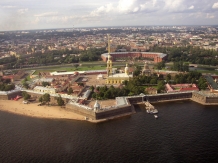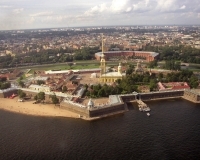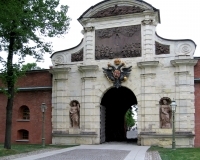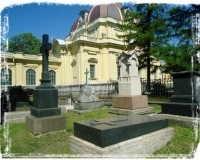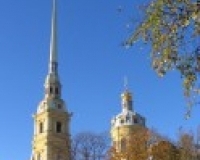The Peter and Paul Fortress
The Peter and Paul Fortress is the historical core of the northern capital. Originally named as “St. Petersburg Fortress”, it gave the name to the city, and May 16 (27) — the date when the foundation stone of the fortress was laid in 1703 — is celebrated as the city’s birthday.
The original designs of the fortress which occupied the entire Zayachy Island were prepared by Saxon engineer Wilhelm Adam Kirstein and French engineer Joseph-Gaspard Lambert de Guerin. The fortification was built according to the latest achievements in European fortification construction, using the bastion fort design developed by outstanding French military engineer Sebastien de Vauban in the 17th century. The first bastion to be founded was the Gosudarev Bastion. Earth ramparts of up to seven meters tall were built on log cribs filled with rocks. The curtain walls were completed by September 1703 and 300 cannons were installed on the walls in October 1703. In 1705, the erection of earth ramparts of a crownwork began. It was an outwork in front of the main fortification and consisted of a full bastion and two half-bastions in the shape of a crown (hence the name). To the north, the crownwork was bordered by the Kronverk Canal. In 1725, the crownwork was reconstructed, and the work was led by great grandfather of Alexander Pushkin Abram Gannibal. Currently, the remains of the Crownwork are located on the grounds of the Military Historical Museum of Artillery, Engineers and Signal Corps.
The reconstruction of the earth and timber fortification in brickwork began on the birthday of Peter I, May 30, 1706. Initially, the bastions were named after Peter’s associates Alexander Menshikov, Gavriil Golovkin, Nikita Zotov, Yuri Trubetskoy, and Kirill Naryshkin. From 1706 onward, the construction work was directed by architect Domenico Trezzini. His design was used to build the Peter’s Gate (built in 1708, rebuilt in 1716-1717). Apostle Peter’s face in the multi-figure relief “Overthrow of Simon the Sorcerer” (by sculptor Konrad Osner) in the tympan of the gate’s attic bears a resemblance to Peter’s. A huge figure of the state double-headed eagle (made by Francois Pascal Vassou) was mounted above the arch in 1720.
The first wooden church of Apostles Peter and Paul was founded in the fortress on Peter’s name day June 29, 1703. The construction of a church in stone to the design of Domenico Trezzini began on the Tsar’s birthday May 30, 1712 and took more than 20 years. The compositional solution and decorative design of the building were inspired by models of North German and Italian architecture. At the entrance to a three-aisled basilica, there is a bell tower topped with a pointed spire with a cross and a flying angel figure. In 1720, a clock with a chiming mechanism of 35 bells that was brought from Holland was installed on the bell tower. In 1722-1727, craftsmen from Moscow guided by Ivan Zarudny carved and gilded a Baroque-style iconostasis which was installed in 1729. On June 29, 1733, the Cathedral was consecrated by Archbishop Feofan (Prokopovich).
Before it was completed, the cathedral was used as the burial place for Peter’s children: Ekaterina (†1708), Natalia (†1715), Margarita (†1715), and Paul (†1717). Princess Charlotte Christine Sophie (†1715), the wife of Tsarevich Alexei Petrovich, was buried under the bell tower. Next to her is the final resting place of the Tsarevich himself who died in 1718. In 1723, Tsarevna Maria Alexeevna, Peter’s stepsister, was buried under the bell tower too. A wooden shrine was built in the cathedral in 1725, and the coffin with the body of the first Russian Emperor was kept there before he was buried in May 1731. Empress Catherine I died on May 6, 1727. After ten days of viewing, her coffin was brought to the St. Peter and Paul Cathedral where it stood next to the Emperor’s coffin until she was buried on May 29, 1731. Empress Anna Ivanovna was buried in the Cathedral on December 23, 1740. Empress Elisabeth Petrovna was buried next to her parents on February 3, 1762, the fortieth day after her death. In 1865–1867, all the old tombstones in the Cathedral were replaced with new, uniform sarcophagi of white marble designed by architect Auguste-Charles Poireau. In 1998, the ashes of the last Emperor Nicholas II and his family members were buried in the St. Catherine’s chapel. With the reburial of Empress Maria Fedorovna, the wife of Alexander III, in 2006, the Cathedral has become the burial place of all the Russian monarchs who ruled between 1741 and 1917.
In 1896-1908, the Grand Ducal Burial Vault (architects David Grimm, Antony Tomishko, and Leon Benois) was annexed to the Cathedral.
The Commandant’s Cemetery near the eastern facade of the Peter and Paul Cathedral began to be used for burials in 1720, with the funeral of Peter’s associate Robert Bruce, which took place in the presence of Peter I. It is the burial place for nineteen of the thirty two commandants of the Peter and Paul Fortress, including colonel Mikhail Chemezov (†1723) and brigadier Yakov Bakhmiotov (†1725) who were buried during Peter’s times. The cast iron tombstone on the Robert Bruce’s tomb is surviving, and new marble tombstones were installed on Chemezov’s and Bakhmiotov’s tombs. The last burial at the Commandant’s Cemetery dates back to 1914, when the ashes of Adjutant General Vladimir Danilov who became the Commandant in 1913 were laid to rest there.
In 1731–1740, the fortress was finally reconstructed in stone to designs and under the guidance of Field Marshal Burkhard Christoph von Münnich. The height of its brick scarps reached 11.5 meters and the thickness of the walls (including interior rooms) was up to 20 – 21 meters. The bastions and curtain walls on the side fronting the Neva River were finished in granite in 1779 –1786. The other walls are open brickwork floated smooth and painted in pink.
In the early 18th century, the Fortress began to be used as a political prison. In 1718, the Secret Office was established there. The prisoners of the fortress, with the first one being Tsarevich Alexei Petrovich (Peter’s son), were kept in prison cells of the Trubetskoy Bastion and other parts of the fortress.
In the northern part of Cathedral Square, there is the Boat House (built by architect Alexander Wist in 1762-1765). It is a small plastered stone pavilion with two porticos and a high figured roof. It was intended for storing the Botik of Peter the Great — a little boat referred to as the “Grandfather of the Russian Fleet” which was kept there from 1765 to 1928 (and is currently exhibited in the Central Naval Museum of St. Petersburg).
In June 1991, a bronze sculpture of Peter I by modern sculptor Mikhail Shemyakin was installed near the Peter and Paul Cathedral. It is a modern interpretation of the famous Wax Person made by sculptor Bartolomeo Carlo Rastrelli based on Peter’s life and death wax masks in 1725. Depicted by Shemyakin, the representation of Peter is fundamentally ambiguous, with his figure being pronouncedly grotesque and the natural proportions of the body and limbs distorted.
Since the first years of its existence, the Peter and Paul Fortress has been the central venue for city’s festivals and celebrations. The first artillery salute from the walls of the fortress was given on May 14, 1704. The cannonade from the fortress marked the days of victories, birthdays, name days and wedding days of the royal family members. The breakup of ice on the Neva River, a traditional festival in St. Petersburg which was first mentioned in 1719, is also associated with the fortress.
In the 1920s, some of the facilities in the fortress were opened as a museum. Since 1954, the fortress has been the main part of the State Museum of the History of St. Petersburg (Leningrad). The Peter and Paul Cathedral is occasionally used to hold worship services.


